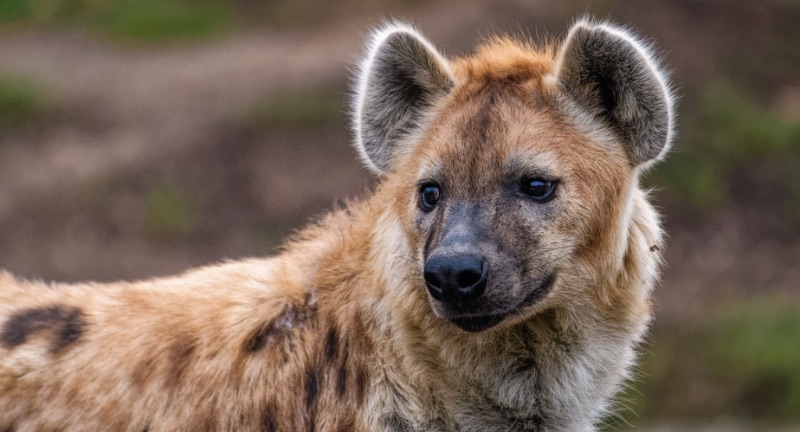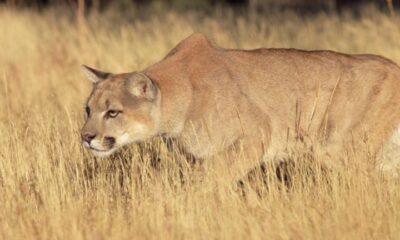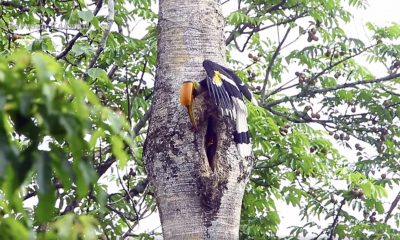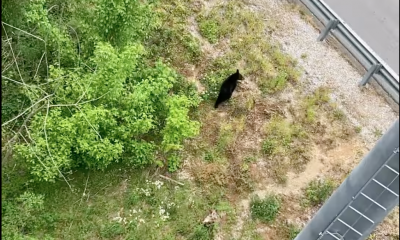NEWS
24 Common Misconceptions About Hyenas
Published
2 months agoon

Shutterstock
Hyenas have long been misunderstood, often associated with eerie calls and sneaky behavior. Their reputation for being cowardly scavengers has overshadowed their true nature as adaptable hunters and skilled communicators. In reality, hyenas are remarkably intelligent, live in complex societies, and play a vital role in their ecosystems.
They thrive in diverse environments, contributing to the health of savannas by regulating prey populations and cleaning up carrion. Let’s dive in and discover how here is much more to these creatures than the myths that surround them.
A Reputation on Trial

Shutterstock
Hyenas have long been saddled with an image of cackling scavengers lurking in the shadows. Many myths portray them as cowardly thieves, stealing meals from lions or feasting solely on carrion. In reality, these hardy mammals are prolific hunters, capable of taking down large prey with remarkable teamwork. Their misunderstood reputation has overshadowed their critical roles in maintaining balance within African ecosystems.
Four Species, One Family

Shutterstock
Though often lumped together, the hyena family actually comprises four distinct species: spotted, striped, brown, and the aardwolf. Each species has unique traits and habitats, ranging from expansive savannas to harsh, arid deserts. Spotted hyenas are the largest and most studied, known for their intelligent, matriarchal social structures. The aardwolf, meanwhile, feeds primarily on termites and hardly fits the popular scavenger stereotype.
Masters of Adaptation

Shutterstock
Hyenas thrive in diverse environments, from open grasslands to rocky highlands and semi-deserts. Their success stems from a tough physiology and resourceful foraging strategies that let them exploit almost any food source. Armed with powerful jaws and a robust digestive system, they can consume nearly every part of a carcass. This versatility often makes them more resilient than other predators when resources are scarce.
Extraordinary Social Hierarchies

Shutterstock
Spotted hyenas live in matriarchal clans where dominant females rule the roost. Females are larger and more aggressive, securing prime feeding opportunities for themselves and their offspring. Clan members cooperate in hunting and territorial defense, using a combination of vocalizations, scent marking, and ritualized displays of power. This tightly knit structure is as socially complex as many primate communities.
Vocalization and Communication

Shutterstock
Hyenas are famous for their iconic “laugh,” yet this giggle is just one of many vocalizations used to convey intricate messages. Their repertoire includes whoops, growls, whines, and giggles that can signal excitement, submission, or even distress. Each hyena’s whoop has a unique pitch, allowing clan members to identify one another across long distances. This sophisticated communication network is crucial for coordinating group hunts and maintaining social bonds.
Skilled Hunters, Not Just Scavengers

Shutterstock
Despite their scavenging reputation, spotted hyenas hunt up to 75% of their own food. They form coordinated parties to chase down large prey like wildebeests, zebras, and antelopes, relying on stamina rather than short bursts of speed. Their exceptionally strong bite force, one of the highest relative to body size, ensures that prey rarely escapes once caught. Scavenging remains a fallback strategy that simply highlights their adaptability to use every available resource.
Ecological Clean-Up Crew

Shutterstock
When hyenas do scavenge, they provide a vital service by cleaning up the savanna. Consuming carcasses left behind by other predators helps prevent the spread of diseases and recycles nutrients back into the environment. Their powerful digestive systems can break down bone, hooves, and horns—parts that other carnivores often leave behind. In this way, hyenas help maintain healthier habitats by removing waste that could otherwise attract pests or contaminate water sources.
Cooperative Parenting

Shutterstock
Hyena cubs are typically born in communal dens, where multiple mothers raise offspring together. Female dominance extends to the cubs, as a mother’s social rank directly influences the status of her young. Cubs nurse for longer than many other carnivores, allowing them to grow stronger and more capable of handling clan life. This communal nursery offers a safe space for cubs to learn social skills through playful interactions.
The Power of the Matriarch

Shutterstock
A dominant female controls much of the clan’s resources, earning first dibs at kills and greater social power. This role often passes down through her lineage, ensuring her offspring inherit a higher social standing. High-ranking females enjoy better access to food and mates, helping them produce healthier cubs. The matriarchal system provides stable leadership and cohesion within the clan.
Remarkable Intelligence

Shutterstock
Research shows that hyenas possess problem-solving skills comparable to many primates. They can figure out how to pull on ropes or move barriers to access hidden food rewards, demonstrating impressive cognitive abilities. Social complexity further highlights their intelligence: hyenas recognize clan members, remember allies, and navigate clan politics effectively. Their cunning and adaptability challenge the simplistic labels they’ve been given over time.
Unique Physiology and Appearance

Shutterstock
Hyenas have front legs longer than their hind legs, creating a distinctive downward sloping back. Their robust skulls and jaw muscles enable them to crush bones to extract vital nutrients like marrow. Spotted hyenas exhibit a patchwork coat of rosettes, while striped and brown hyenas sport bold stripes and shaggy manes, respectively. These distinctive features help researchers quickly identify species and study their behavior in the wild.
Challenges in Conservation

Shutterstock
Hyenas face numerous threats including habitat encroachment, human-wildlife conflict, and retaliatory killings by livestock owners. They are often viewed as pests or dangers to community livelihoods, leading to persecution that further diminishes their numbers. Conservation initiatives increasingly aim to educate local communities about hyenas’ ecological value, promoting peaceful coexistence. Effective land management and conflict resolution are vital to ensuring a sustainable future for these misunderstood carnivores.
Cultural Symbolism

Shutterstock
Hyenas have occupied a broad range of symbolic roles in African folklore, from mischievous tricksters to ominous omens. Some cultures see them as negative forces associated with witchcraft, while others regard them as important spiritual intermediaries. These conflicting views reflect an age-old fascination with the hyena’s eerie calls and nocturnal habits. Delving into these traditions reveals a nuanced relationship between humans and hyenas that is deeply rooted in myth and legend.
Role in Disease Control

Shutterstock
By rapidly consuming carrion, hyenas reduce the proliferation of harmful bacteria and pathogens in the environment. Their highly acidic digestive systems can break down and neutralize many organisms that could otherwise spread disease. This ecological clean-up service makes them key players in preventing epidemics among wildlife and even neighboring human populations. In essence, their appetite for leftovers contributes to overall ecosystem health.
Adaptations for Endurance

Shutterstock
Spotted hyenas excel at distance-based hunting, depending on stamina rather than a sudden sprint to capture prey. Their sturdy neck muscles and efficient cardiovascular systems support these prolonged chases across vast savannas. This strategy allows them to wear down large herbivores before delivering a powerful bite. Such endurance-based tactics highlight the resilience and determination that underpins their hunting success.
Territorial Defense and Cooperation

Shutterstock
Spotted hyena clans can consist of over 80 individuals, cooperating diligently to defend key territory. They mark boundaries with scent from specialized anal glands, sending a clear warning to any would-be intruders. When rival clans or predators do cross the line, the resident clan bands together with vocal intimidations and aggressive tactics to drive them out. This united defense prevents resource depletion and secures valuable hunting grounds for future generations.
Surprising Social Flexibility

Shutterstock
Within the clan, smaller subgroups often form based on kinship, rank, or personal preference. Individual hyenas can shift between these factions, forging new alliances or renegotiating existing relationships. Despite competitive undercurrents, cooperation remains pivotal for successful group hunts and facing off against larger enemies, such as lions. This social agility allows hyenas to adapt to evolving circumstances while maintaining overall clan stability.
Predator vs. Prey Balancing Act

Shutterstock
Hyenas share African landscapes with lions, leopards, and wild dogs, leading to both fierce competition and mutual checks on prey populations. Sometimes they strategically outnumber smaller predators to seize carcasses; other times, they lose contests to bigger or more powerful rivals. These dynamic interactions keep prey species from overpopulating and ensure that no single predator dominates. Consequently, the equilibrium of the savanna is maintained through constant give-and-take among top carnivores.
Nighttime Vigilantes

Shutterstock
While hyenas are active both day and night, much of their hunting and territorial patrols happen after sundown. They possess exceptional night vision and keen hearing, providing an edge when stalking prey under the cover of darkness. Nocturnal tendencies also help them avoid direct conflicts with diurnal hunters like lions during peak daylight hours. By dividing activity periods, predators collectively reduce competition and spread hunting pressure across different times.
Complex Courtship and Mating

Shutterstock
Male hyenas must gain acceptance from dominant females, often through patient courting and submissive behavior. Females, especially those higher in rank, select mates based on their suitability and social standing. This process can be lengthy, involving careful displays and measured approaches to avoid aggression. Ultimately, these nuanced courtship rituals ensure that strong, healthy genes are passed on to future generations.
Evidence of Tool-Like Behavior

Shutterstock
Captive and field studies have noted instances of hyenas manipulating objects to solve problems. They might move barriers, roll logs into position, or shift rocks to better reach a source of food. Though not as commonly documented as tool use in primates, these findings suggest a curious streak and capacity for innovative thinking. Such adaptability underscores their notable intelligence and ability to learn from their environment.
Misunderstood Laughter

Shutterstock
The giggling or “laughing” sound most famously linked to hyenas conveys far more than comic mischief. Often, it signals social excitement, submissive behavior, or even nervous energy during tense interactions. Variations in pitch and duration let clan members gauge a hyena’s emotional state and intentions. Recognizing these subtleties helps dismantle the myth of mindless cackling, revealing a nuanced communication system at work.
Indicator of Ecosystem Health

Shutterstock
As both apex and mesopredators, hyenas influence prey populations and help maintain biodiversity. A decline in their numbers can reflect broader issues such as habitat loss, overhunting, or deteriorating prey availability. Monitoring hyena populations thus gives conservationists vital clues about the health of African landscapes. Protecting them is not only about saving one species, but also about preserving the intricate balance of the savanna.
Embracing Their True Identity

Shutterstock
Hyenas are neither mere scavengers nor evil tricksters—they are vital, intelligent, and deeply social carnivores. Their matriarchal clans, hunting prowess, and robust adaptability paint a much richer picture than myths suggest. Recognizing the complexity of hyena behavior fosters a deeper appreciation for their indispensable roles in Africa’s wild tapestry. By understanding them better, we can shift the narrative from “scavenger” to “savior,” acknowledging hyenas as misunderstood guardians of the savanna.
Conclusion

Shutterstock
Hyenas challenge us to see beyond their eerie calls and fierce reputation, reminding us that nature is full of misunderstood marvels. By observing their social bonds, intelligence, and adaptability, we uncover a creature that is both vital to its environment and intriguing in its own right. Dispelling myths and broadening our understanding helps ensure that these key players in the wild have a chance to thrive. Ultimately, hyenas stand as a reminder that sometimes the creatures we fear hold the greatest secrets to maintaining balance in the natural world.
More Amazing Animals+
-


25 Reasons Why Chihuahuas Are Big Dogs in Small Packages
-


Alligator arrest outside of a school in Charleston, SC
-


19 Astonishing Facts About Mountain Lions Most Didn’t Know
-


25 Lovable Traits of the English Springer Spaniel
-


25 Things That Make Pharaoh Hounds Perfectly Exotic
-


More – Orphaned bear cubs playing in tree and post-rescue…
-


24 Ways Hippos Are Even Cooler Than You Thought
-


Danish Royal Life Guards escort duck family to Copenhagen harbor
-


The most beautiful thing you will watch today. Great #Hornbill…
-


Bear sightings from the Anakeesta Chairlift! #WildBears #MomandCubs
-


25 Reasons Why Malamutes Are the Kings of the Arctic
-


25 Things To Love About The Chesapeake Bay Retriever
